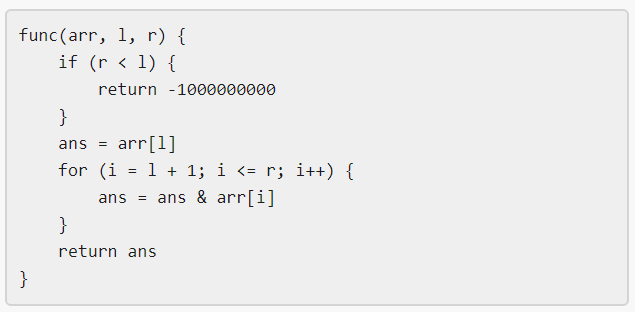2021-04-12 Daily-Challenge
Today I have done Find a Value of a Mysterious Function Closest to Target and leetcode's April LeetCoding Challenge with cpp.
Find a Value of a Mysterious Function Closest to Target
Description

Winston was given the above mysterious function func. He has an integer array arr and an integer target and he wants to find the values l and r that make the value |func(arr, l, r) - target| minimum possible.
Return the minimum possible value of |func(arr, l, r) - target|.
Notice that func should be called with the values l and r where 0 <= l, r < arr.length.
Example 1:
Input: arr = [9,12,3,7,15], target = 5
Output: 2
Explanation: Calling func with all the pairs of [l,r] = [[0,0],[1,1],[2,2],[3,3],[4,4],[0,1],[1,2],[2,3],[3,4],[0,2],[1,3],[2,4],[0,3],[1,4],[0,4]], Winston got the following results [9,12,3,7,15,8,0,3,7,0,0,3,0,0,0]. The value closest to 5 is 7 and 3, thus the minimum difference is 2.
Example 2:
Input: arr = [1000000,1000000,1000000], target = 1
Output: 999999
Explanation: Winston called the func with all possible values of [l,r] and he always got 1000000, thus the min difference is 999999.
Example 3:
Input: arr = [1,2,4,8,16], target = 0
Output: 0
Constraints:
1 <= arr.length <= 1051 <= arr[i] <= 1060 <= target <= 107
Solution
because union operation can only make value smaller, just enumerate every possible bit
const int maxBit(int x) {
for(int i = 30; i >= 0 ; --i){
if((1 << i) & x) return (1 << i);
}
return -1;
}
class Solution {
int len;
int closestToOneBit(vector<int>& arr, int bit, int target) {
int pos = 0;
int result = INT_MAX;
while(pos < len) {
if(!(arr[pos] & bit)) {
pos += 1;
} else {
int res = arr[pos];
while(pos < len && (arr[pos] & bit)) {
res &= arr[pos];
pos += 1;
}
result = min(result, abs(res - target));
}
}
return result;
}
public:
int closestToTarget(vector<int>& arr, int target) {
int all = (1 << 26) - 1;
len = arr.size();
int mmax = 0;
for(auto n : arr) {
mmax = max(n, mmax);
all &= n;
}
if(mmax <= target) return target - mmax;
if(all >= target) return all - target;
int bit = (maxBit(target) << 1);
int answer = INT_MAX;
while(bit) {
answer = min(answer, closestToOneBit(arr, bit, target));
bit >>= 1;
}
return answer;
}
};
April LeetCoding challenge 12
Description
Beautiful Arrangement II
Given two integers n and k, you need to construct a list which contains n different positive integers ranging from 1 to n and obeys the following requirement:
Suppose this list is [a1, a2, a3, ... , an], then the list [|a1 - a2|, |a2 - a3|, |a3 - a4|, ... , |an-1 - an|] has exactly k distinct integers.
If there are multiple answers, print any of them.
Example 1:
Input: n = 3, k = 1
Output: [1, 2, 3]
Explanation: The [1, 2, 3] has three different positive integers ranging from 1 to 3, and the [1, 1] has exactly 1 distinct integer: 1.
Example 2:
Input: n = 3, k = 2
Output: [1, 3, 2]
Explanation: The [1, 3, 2] has three different positive integers ranging from 1 to 3, and the [2, 1] has exactly 2 distinct integers: 1 and 2.
Note:
- The
nandkare in the range 1 <= k < n <= 104.
Solution
class Solution {
public:
vector<int> constructArray(int n, int k) {
vector<int> answer;
while(n > k + 1) {
answer.push_back(n);
n -= 1;
}
if(k == 1) {
answer.push_back(2);
answer.push_back(1);
return answer;
}
int cur = (n + 1) >> 1;
int sign = 1;
answer.push_back(cur);
for(int i = 1; i <= k; ++i) {
cur += sign * i;
answer.push_back(cur);
sign = -sign;
}
return answer;
}
};